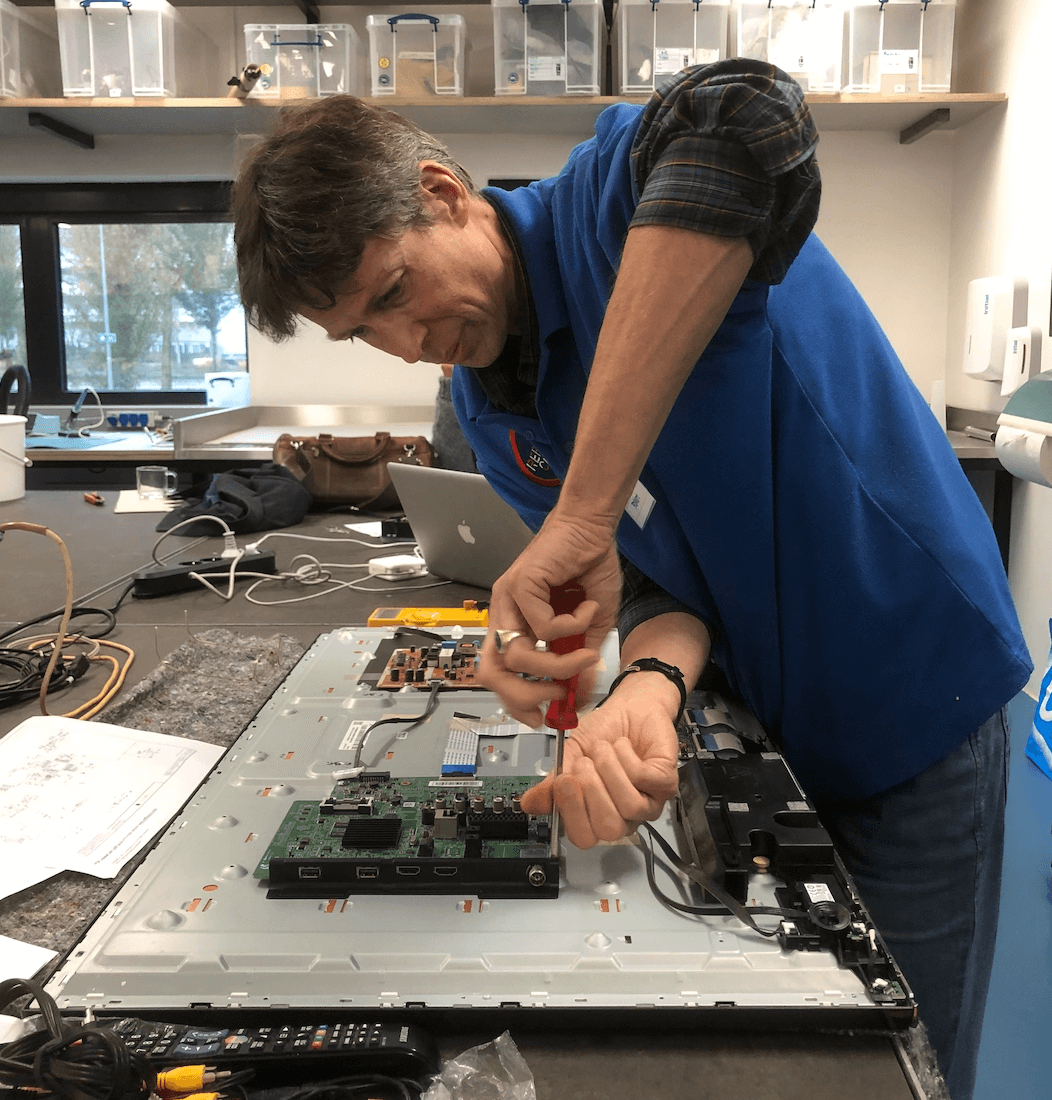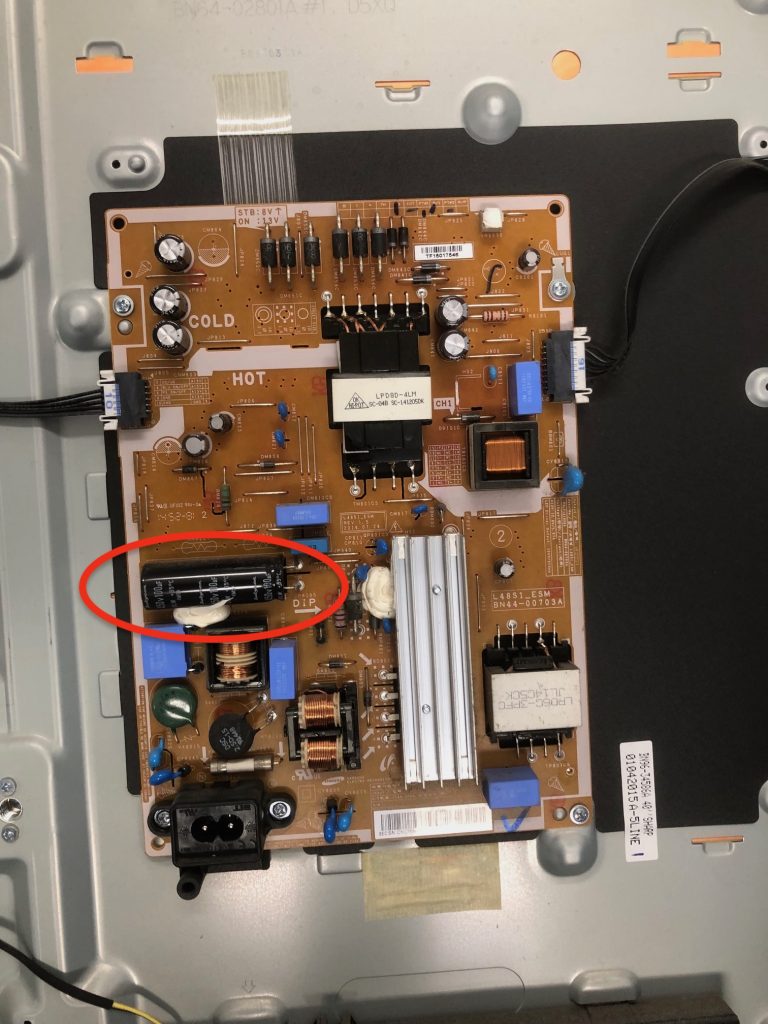
Do you have a problem with your television? Then, consider very carefully whether you want to fix it yourself. Tinkering with televisions can be dangerous. This article explains how and under what conditions making repairs is safe.
Many Repair Cafés opt never to repair televisions because of the high voltage of these appliances. This is especially true of old picture tube televisions (pre-2000). Such picture tubes can carry a deadly high voltage of up to 30,000 volts. Unplugging it will not remove this voltage. Therefore, dismantling a picture tube television without sound electrical expertise is hazardous.
TV repairers must know precisely what they are doing
Despite this, banning televisions from the Repair Café is unnecessary. However, repairers must know precisely what they are doing. At Repair Café Delft in the Netherlands, they do. This is one of the Repair Cafés where visitors can bring televisions.
“We have had over a hundred TVs on the workbench since 2017,” says repairer Bart Jan van der Ceelen. “Almost all of these are LED or LCD TVs. These days, hardly anyone still has an old picture tube TV.”
Television supply capacitors contain dangerous amounts of electrical charge
LED or LCD TVs are no more hazardous than many other electrical devices, according to Bart Jan. “With one exception: the power supply capacitors. These can still contain a dangerous amount of electrical charge for quite some time, even after the main voltage is disconnected. So, safely discharge these capacitors first.”
 Modern televisions have a circuit board with capacitors, fuses and other elements attached. The power supply capacitor is the circled part – it carries 450 volts.
Modern televisions have a circuit board with capacitors, fuses and other elements attached. The power supply capacitor is the circled part – it carries 450 volts.
Repair Café Delft has created a poster explaining why and how to do this. “Using that poster, we educate our repairers and explain the basics,” says Bart Jan. Meanwhile, Repair Café Delft has also made a discharge tool. “It is simple but safe.”
 Impression of the discharge tool: The tool is the wooden block with the bulb, the cords and the grip clips that go into the amplifier. When you turn off the amplifier, the capacitors discharge through the bulb. With the voltmeter, you can measure the remaining voltage and determine when the capacitors are discharged. Foto: Repair Café Delft
Impression of the discharge tool: The tool is the wooden block with the bulb, the cords and the grip clips that go into the amplifier. When you turn off the amplifier, the capacitors discharge through the bulb. With the voltmeter, you can measure the remaining voltage and determine when the capacitors are discharged. Foto: Repair Café Delft
You can safely test televisions after discharging the capacitors
After discharging the capacitors, repairers can safely test various things. “You can then inspect it,” explains Bart Jan. “Sometimes, you get some clues just by looking: you can reattach loose cables, measure a blown fuse for resistance and replace, replace a bulging electrolytic capacitor, measure diodes and transistors… And remember the toothbrush or paintbrush trick! Several repairers got a dusty television working again by brushing it off with a toothbrush or paintbrush.”
Working with voltage: always with one hand on the back and always with an isolating transformer
If the above does not result in the television working again, power must still be applied to diagnose the problem. “You then want to measure a few things. This usually involves comparing voltages with what it says in the service manual, electrical diagram, or what you know from experience.”
Repair Café Delft also follows some essential rules for this work. For example, repairers should always work with one hand on their back or in a pocket and always with an isolation transformer. “If you do that, you will be protected by the isolating transformer. We made a poster about this, too.”
Television repairs in the RepairMonitor
That not all Repair Cafés ban televisions is confirmed by the RepairMonitor. Repair Cafés worldwide keep track of their repair data in this online tool. By the end of 2023, the monitor contained more than 750 television repairs carried out at more than a hundred Repair Cafés in several countries. Thirty-three per cent of the repairs made were successful. In most of these cases, capacitors, fuses, LEDs or backlights were replaced (as in this video, recorded by a Repair Café Helmond-Oost volunteer)
More information
- Watch this video in which a Repair Café Helmond-Oost volunteer replaces LEDs in a Samsung Smart TV
- For questions on this subject, please get in touch with Repair Café Delft
- Are you curious about the information on television repairs in RepairMonitor? Download the entire dataset via the RepairMonitor dashboard.

Fortunately, technology has moved on from picture-tube-based displays, and even from fluorescent backlights on older LCD flat-screens. There are few places in newer products where high-voltage capacitors will remain charged after the mains are disconnected. The remaining exception here is with microwave ovens, which have a potentially-lethal high-voltage capacitor that might not have a bleed resistor across it. Always use a multimeter to ensure things are discharged before touching them, and keep disconnected mains plugs in your field of vision.
This article seems to suggest leaving the bulb and clips connected while operating the device (stereo). That’s not OK because the bulb will draw current from the stereo. Momentary connection after power turned off would be a safer alternative, with insulated clips and great care.
In reply to Stan: the correct method to discharge the capacitors is indeed with the mains disconnected. The picture was made for illustration purposes. It has been made with the mains connected in order to show the voltage across the capacitors and at she same time show the glowing light bulb. When the insulated clips are attached while the mains is disconnected, the voltage will drop (very) quickly through the low resistance light bulb. The light bulb may/may not show some light, depending on the energy stored in the capacitors and also depending on the light bulb rated power.
In reply to Dean: the high voltage capacitor on the primary side of SMPS (switched mode power supply) is present in many modern electronic devices and may also pose a safety risk.
Safety first!
We (the Boulder U-Fix-It Clinic) wrote a Microwave Oven Diagnosis and Repair guide and shared it on:
https://www.boulderufixitclinic.org/repair-resources
https://docs.google.com/document/d/1iPLeyMYtYwAYYqjfBloGxHalCGik0mpwDZLyRTqeHrU/edit?usp=sharing
Our experience with microwave oven repairs is that the door safety micro switches are the most common problem. ($0.34 USD each on Amazon in packs of 10. Free if you harvest them from unrepairable appliances!)
Easy and inexpensive to replace